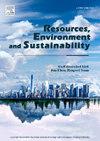Beyond trade-offs in China’s vegetation-economy dynamics
IF 12.4
Q1 ENVIRONMENTAL SCIENCES
引用次数: 0
Abstract
Effectively achieving the United Nations’ Sustainable Development Goals (SDGs) alongside climate change adaptation and mitigation actions requires recognizing synergies and trade-offs among various targets. The relationship between vegetation conservation and economic development is complex and context-dependent across different regions and scales, and the lack of long-term and large-scale data remains a challenge in fully verifying this relationship. Existing area-based vegetation conservation metrics did not account for the ecological heterogeneity of vegetation zones. We proposed a zonal vegetation ratio to measure the extent of conservation of zonal vegetation, defined as the proportion of zonal vegetation area to the total area within a region. We analyzed the relationship of the zonal vegetation ratio with economic levels and Net Primary Productivity (NPP) using three decades of data from more than 2,000 rural counties (94.1% of the total land area) in China. Although the zonal vegetation ratio showed negative correlations with per area economic indicators and NPP nationally, variations occurred across vegetation zones. The relationship was mutually beneficial in the desert and alpine zones, which suggested that vegetation conservation and economic growth could coexist under certain conditions. After controlling for individual and temporal effects, the zonal vegetation ratio positively impacted fiscal revenue. Dynamic panel analyses suggested a potential positive causal link between the zonal vegetation ratio and fiscal revenue, although unobserved external factors limited causal certainty. These findings advocate for context-specific policies to align vegetation conservation and economic development. They highlight the need for further research to validate causal relationships and inform policy formulation.

超越中国植被经济动态的权衡
要在适应和减缓气候变化行动的同时有效实现联合国可持续发展目标,就需要认识到各种目标之间的协同作用和权衡。植被保护与经济发展之间的关系在不同区域和尺度上具有复杂的背景依赖性,缺乏长期和大尺度的数据仍然是充分验证这种关系的挑战。现有的基于区域的植被保护指标没有考虑到植被带的生态异质性。我们提出了地带性植被比例来衡量地带性植被的保护程度,定义为地带性植被面积占区域内总面积的比例。我们利用中国2000多个农村县(约占总土地面积的94.1%)30年的数据,分析了地带性植被比与经济水平和净初级生产力(NPP)的关系。地带性植被比与全国各区域经济指标和NPP呈负相关,但各植被带间存在差异。在荒漠和高寒地区,这种关系是互利的,这表明在一定条件下,植被保护和经济增长可以共存。在控制个体和时间效应后,地带性植被比正影响财政收入。动态面板分析表明,地带性植被比与财政收入之间存在潜在的正因果关系,尽管未观察到的外部因素限制了因果确定性。这些发现提倡采取因地制宜的政策,将植被保护与经济发展结合起来。他们强调需要进一步研究以验证因果关系并为政策制定提供信息。
本文章由计算机程序翻译,如有差异,请以英文原文为准。
求助全文
约1分钟内获得全文
求助全文
来源期刊

Resources Environment and Sustainability
Environmental Science-Environmental Science (miscellaneous)
CiteScore
15.10
自引率
0.00%
发文量
41
审稿时长
33 days
 求助内容:
求助内容: 应助结果提醒方式:
应助结果提醒方式:


